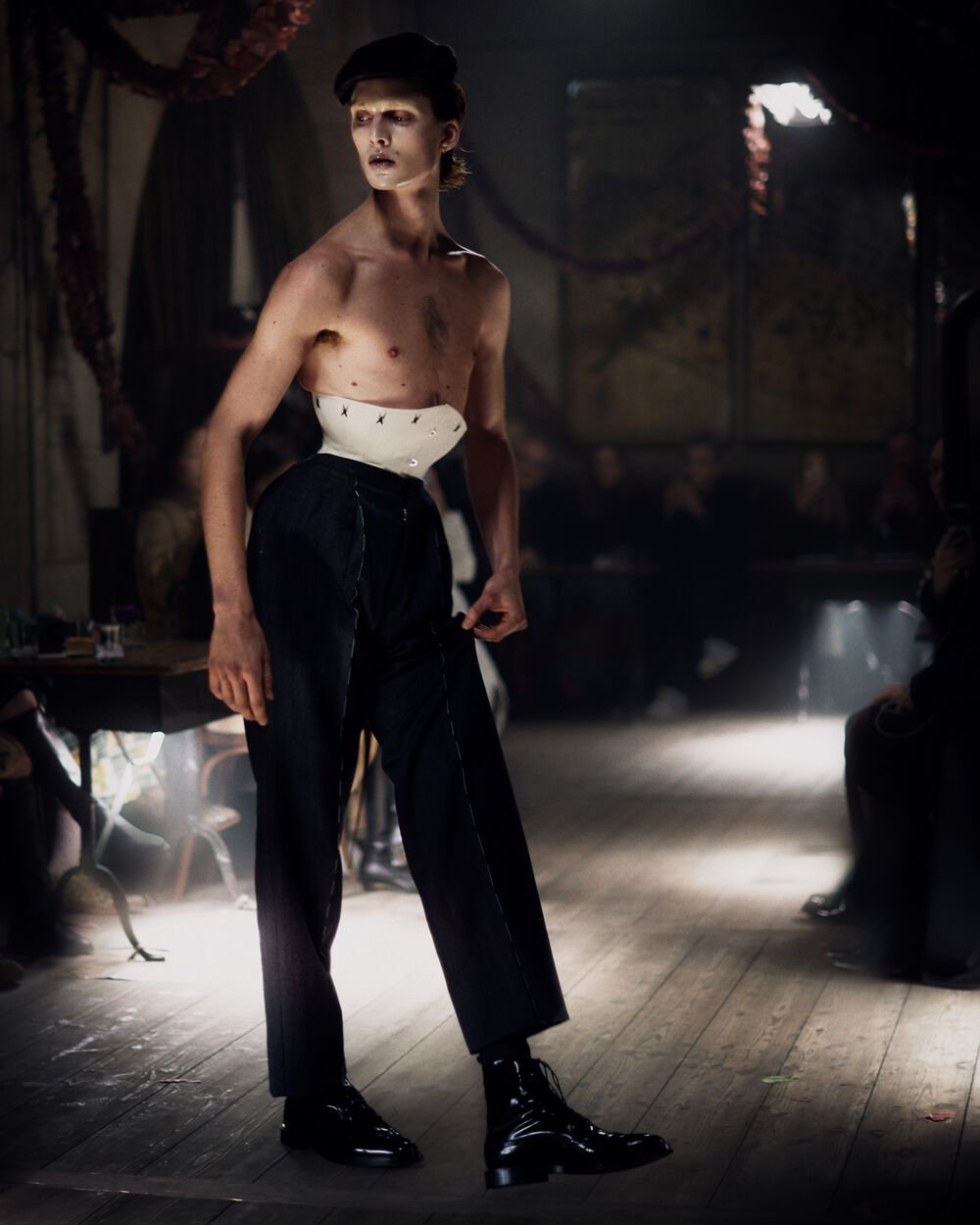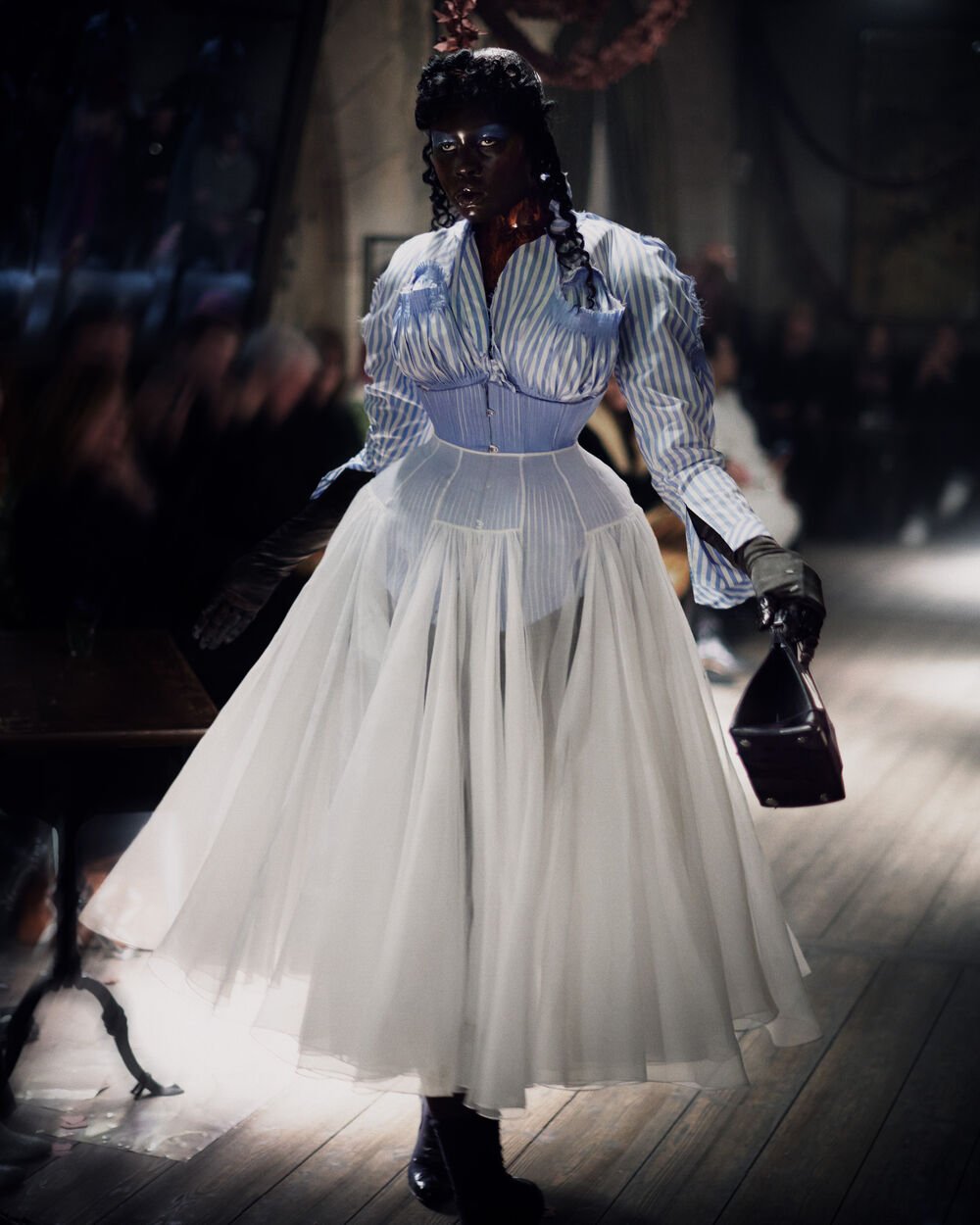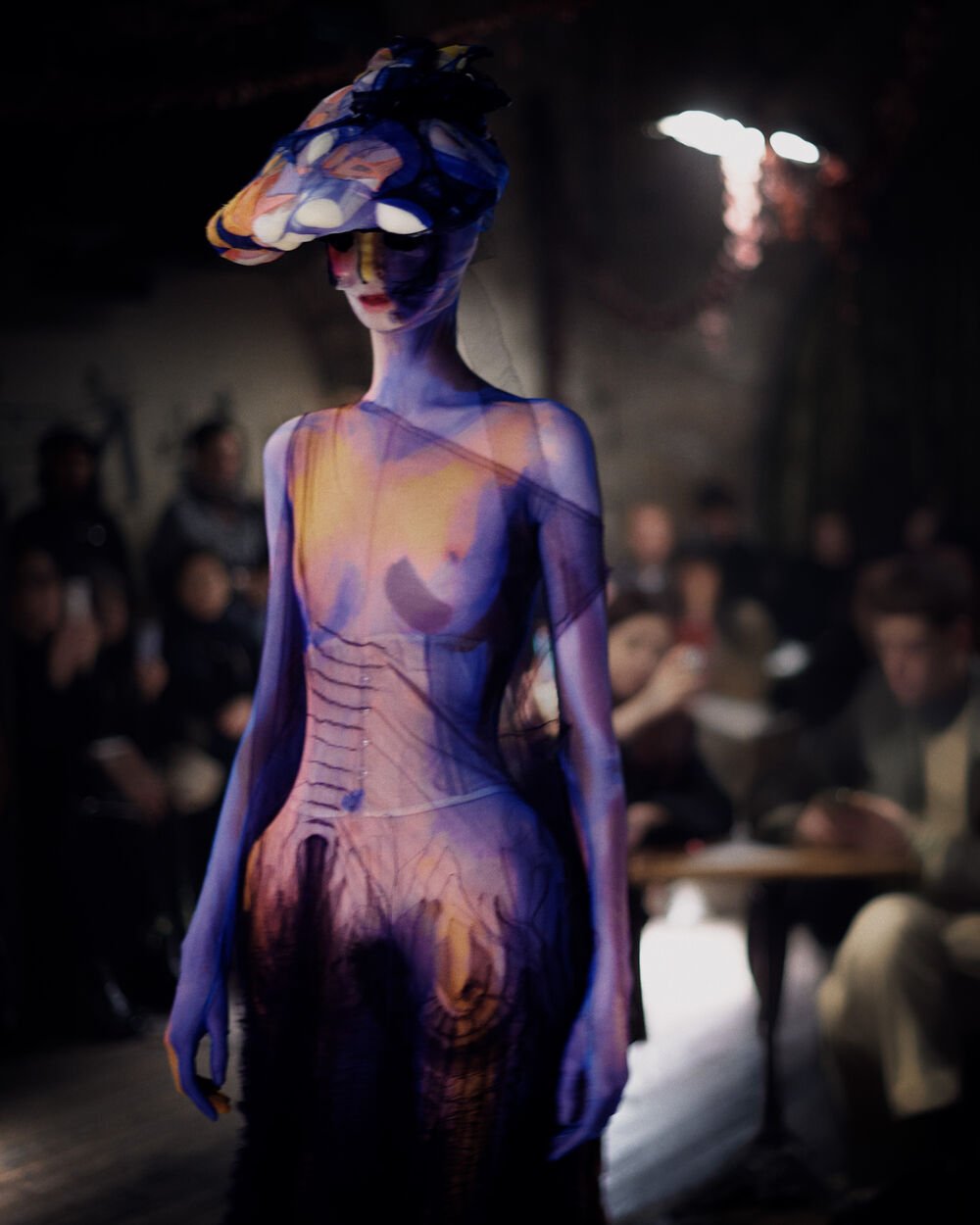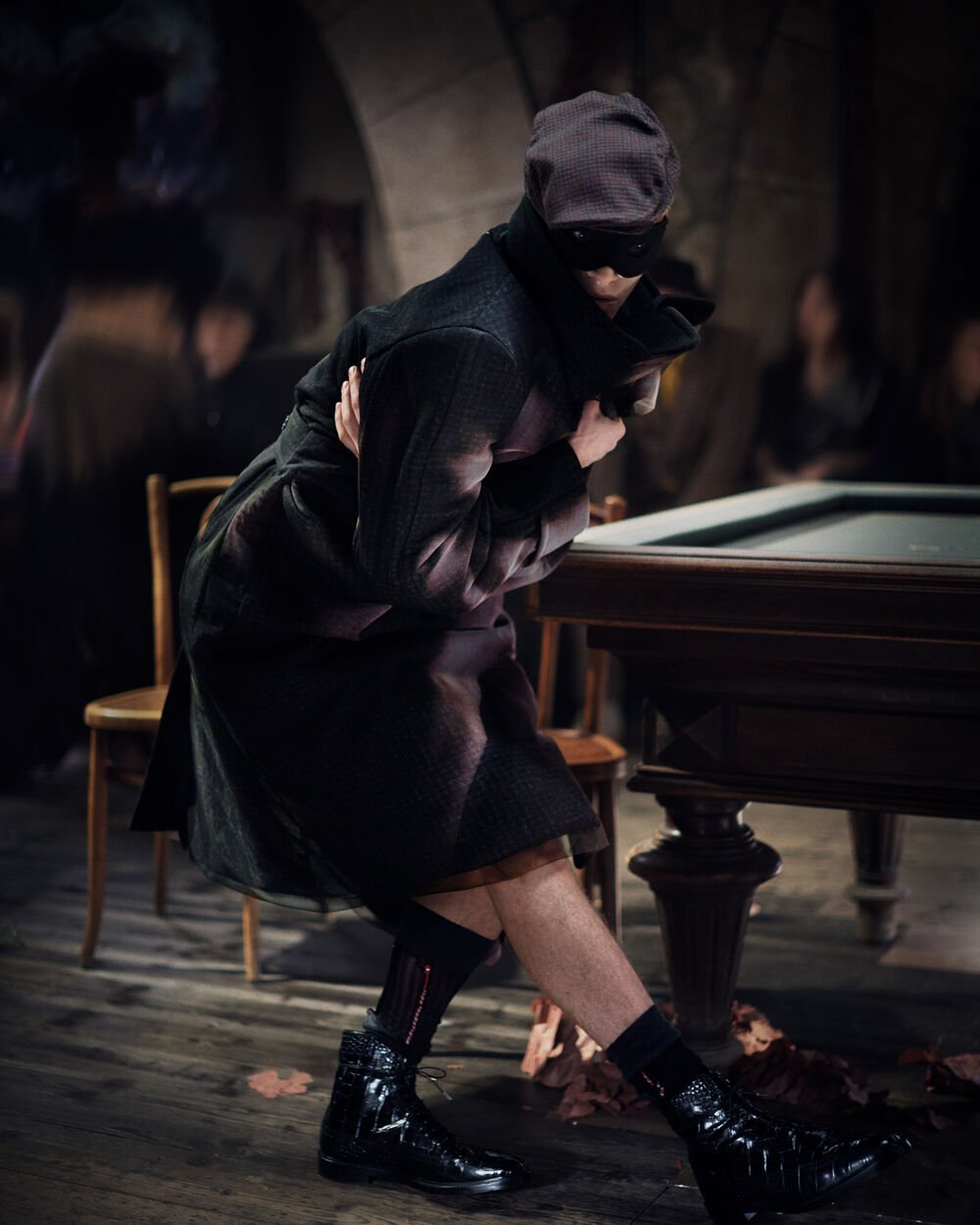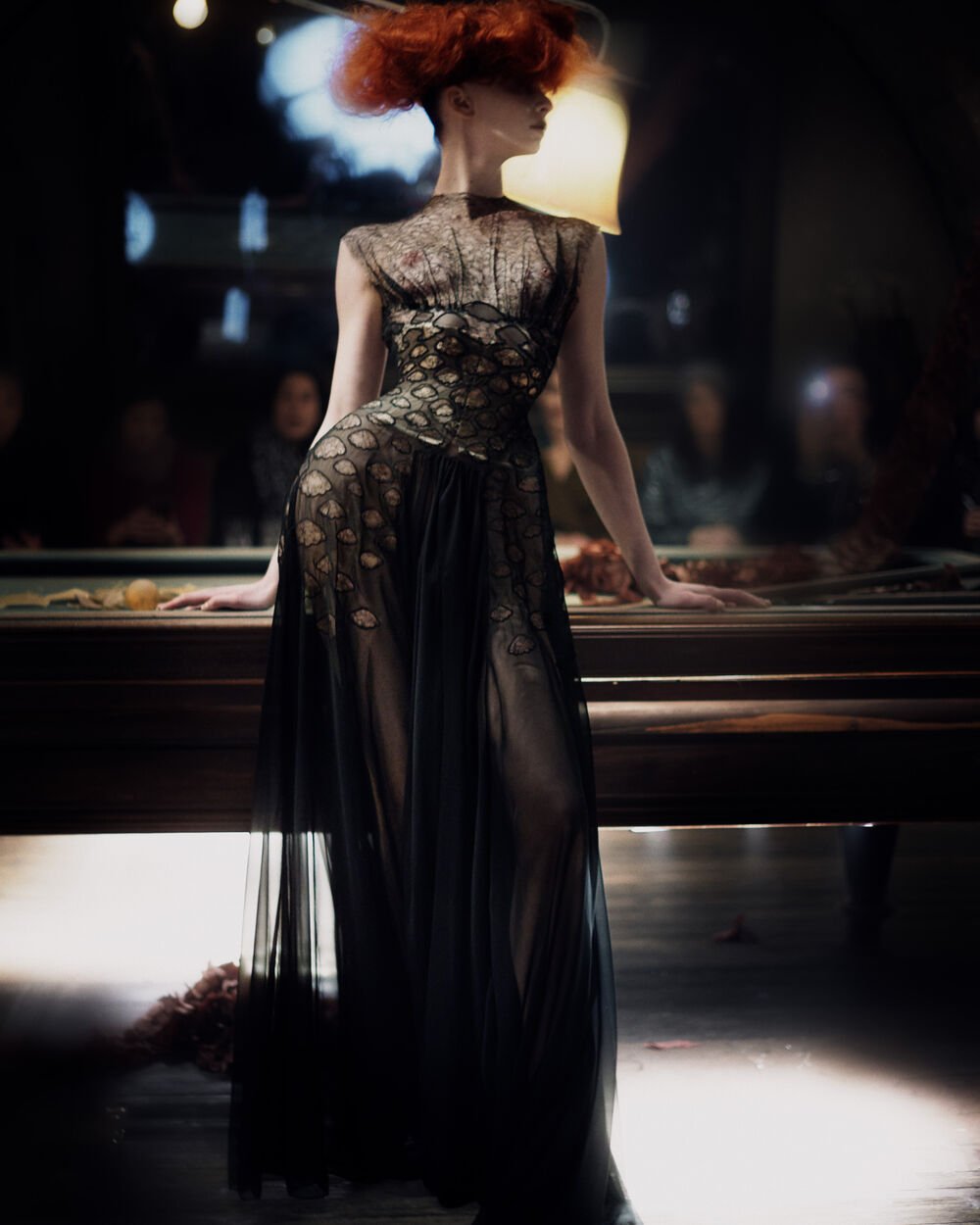Paris Nocturne: Maison Margiela 2024 Haute couture collection
by Sahil Verma
It is such a breath of polluted, cigarette-smoke-filled air to watch Maison Margiela’s 2024 artisanal collection. The ghosts that plagued the nighttime in 1930’s Paris, residing underneath the Ponte Alexandre III seemed to be the epicenter of Galliano’s art style. I say art style because this collection transcends just clothing. It tells a story that we view through shards of broken glass. The run-down, dingy atmosphere that the show was held in transports us to a rancid part of Paris by night, completely unfiltered. The whole show feels like a corset slowly tightening around you. Sheer dresses that dangle eroticism in front of the viewer, the matting of hair, glossing of faces, and extremely sinched waists contradicted by wide-hipped models, seem to satirize beauty norms by exaggeratedly upholding them.
Described as ‘a walkthrough the underbelly of Paris, offline’ the collection walks the line between the living and the dead. In today’s fashion industry, this show stands out because it is so disgustingly beautiful. The bruising of suspiciously ‘clean’ models makes them appear as superior beings. Each step they take makes them appear larger than life. Galiano has made them look tactically weathered and old but also reborn at the same time. They are walking juxtapositions, creating a sort of anemoia, harkening back to a setting that is based in our reality, making us feel nostalgic for a time we know little to nothing about. Galliano has created a world and tells a story that means something different to every single viewer, encouraging them to use their imagination. The show embodies the feeling of awe, in all senses of the word. Awful or awesome but undeniably Awe-inspiring.
Galiano mentions in the press release, in passing, that he was intrigued by the works of Brassaï, which I chose to explore a little further, sending me on a deep dive into his voyeuristic portraiture, where he captures Paris de nuit in the 1930s. Cobbled streets, Big Albert’s gang breaking out in fights, prostitutes looking for work, lovers sitting on benches, cesspool workers taking a break, Brassai captures in photos the pictures that Galiano paints through this collection.
One image that seems to have impacted the collection is titled “A suit for two at the ‘Magic City ’ball, c.1931[1]. Depicting one man dressed from the waist down and the other dressed from the waist up. The look at the forefront of the Margiela collection is a man in loose-fitting dress pants with ultra-extreme corsets that are the highlights of this collection. Some other looks show men dressed in boxer briefs but wearing the top half of a suit, stringing together the outfits in the collection, which was very satisfying to look back on.
The public has shown overwhelmingly positive responses to the collection, calling it timeless and monumental in an era where high fashion is simply glorified clout-chasing. However, the little negative responses to the collection talk about it being linked to drag fashion, which I think is a very hasty generalization. Upon my viewing, I was not reminded of drag fashion in any way. The undertones of voyeurism in the loose storyline of the collection elicited a negative response in some users as well, the discomfort of which I think is what Galiano wanted to focus on. I think that the collection aims to focus on the seams at which Paris was being held together, that became visible under the night lamps and all the dangers that came out of the shadows at night.
From a more technical point of view, everything in the collection is very intentional. It makes abundantly clear the impeccable craftsmanship and surgical precision that courses through the veins of Margiela. Galliano employed 15 different techniques to construct the outfits in this collection, eight of which he invented and used for the first time for this collection. He uses the techniques of Seamlace, Milletrage, retrograding, emotional cutting, Aqaurelling, Rétrécirage, Stripe-tease, Gouttoir coating, Rorschach dotting, reverse swatching, Caisetting, abstract lace, and bias cutting all to reimagine the fashion of 1930s Paris and bring it into 2024. These complex techniques are used to make the outfits look like a part of the setting. Moth holes as deconstructed polka dots, shrunk cloth, moon-centric motifs, and watercolor patterns are just a few things that these techniques were used to create, all of which come together to give the collection a life of its own. Using the body as a canvas, as the models walk down the rancid dungeon underneath the Ponte De Alexandre III, a piece of art is formed, where color fades in and out periodically. The collection exudes the overconfidence that Brassai had for his work and the different walks emphasize the same, making the collection appear transcendent of humanity itself, as it engages with surrealism to appear otherworldly.
I also feel that the show has used size inclusivity exactly in the way it should be used. As per models.com, 23% of the female models who walked the show qualified as curve models. The show placed a special emphasis on the female form, sometimes even using padding to accentuate it but this was one of the most diverse European runways in recent times and did not feel like the tokenistic box-checking that some other brands feel compelled to do.
The designers at Maison Margiela have turned emotional form into physical expression, giving tangible form to feeling and reflecting fragility throughout. We have witnessed a monumental piece in the history of Haute Couture as Galiano blurs the line between fashion and art. Standing in a pile of broken glass, wearing split-toe Louboutin’s, watched through Brassaï’s voyeuristic camera lens, the Maison Margiela artisanal collection studies presence and sentience.
What does this mean for fashion? According to a netizen that goes by arcaic on the forum of thefashionspot.com,
“It seems to me that constant exposure to mediocre fashion and media has left us so hungry for peak fashion that we no longer recognize it when it’s right in front of us. We complain when there’s no theatrics and extravagance, yet we still complain when there is. Do we even know what we want anymore?”
Maison Margiela has chosen to ignore that question and make ‘what we want’ completely irrelevant. Galiano ignores trends, statistics, and popularity and just gives us an exhibition of the sheer craftsmanship that exists at the Maison, down to the most painstaking detail. We are given what is the harsh reality, with all the dirt, grime, and filth but in that mess, our presence and sentience are tested. We are allowed to form expectations, almost encouraged to do so, which are then shattered by every model that walks down the runway.
Cover by Brassaï (Paris De Nuit)

